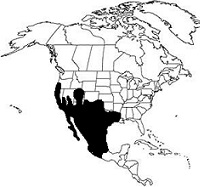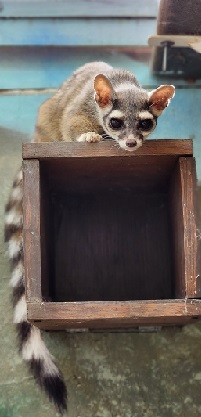Ringtail
Bassariscus astutus
- Habitat: varied habitats from oak forests, woodlands, chaparral habitats, deserts, and rocky cliffs
- Range: widely distributed through south and south-western Mexico and U.S.A
- Natural Diet: fruit, insects, rodents, and birds
- Status in the Wild: Common
All about the Ringtail
Ringtails are closely related to raccoons and coatis. They are light to dark brown in color with a creamish-white underbelly. They have black rings on their long tails which gives them their name. Ringtails have long pointed faces with whiskers and resemble wild dogs. Their brown faces have cream patches around their eyes and snouts. Ringtails are nocturnal and have large eyes and vertically positioned ears to help them navigate at night. Their advanced sense of sight and hearing helps them to successfully hunt their prey. The evolutionary significance of being nocturnal is to hunt when prey is resting. Ringtails are arboreal and often live in tree hollows. They have semi-retractile claws and long tails that help them balance and maneuver while climbing.
Male and female Ringtails look alike and have the same color, shape, and form (monomorphism). They are smaller than raccoons with body lengths of around 1.5 feet. Their tails are as long as their bodies. They can weigh from 1.5 to 3.5 pounds.
Diet/ Habitat/ Range
Ringtails are native to North America and range across the southern United States and Mexico. They live in diverse habitats across their distributional range which include forests, shrublands, grasslands, deserts, and rocky outcrops.
Like raccoons, Ringtails are omnivorous, feeding on fruits, berries, small birds, reptiles, amphibians, and invertebrates.
Behavior
Ringtails, like wild cats, live solitary lives pairing only during the breeding season. Both males and females maintain territories in which they rest, hunt, and feed. They scent-mark the perimeters of their territories with urine and feces. The territories of females are smaller than that of males. The territories of several females are often located within the territory of one male.
Ringtails emit a variety of vocalizations that include squeaks, whimpers, barks, high-pitched calls, and chirps. The high-pitched calls are alarm calls emitted when Ringtails sense the presence of a predator close by. They deter predators by secreting an unpleasant-smelling fluid from their anal glands. Their predators include great horned owls, coyotes, and bobcats.
Reproduction
Males and females pair during the breeding season that occurs in spring. Young are born in the summer months. While males defend their territories and protect their females and young from competition, females take care of and train their young. Female Ringtails select sheltered areas such as dens, tree hollows, burrows, or caves to deliver their young. She remains in this sheltered area while she is carrying her young with the male bringing her food. Two to four kits are born in each litter. Mothers nurse their young for a period of a month to a month and a half after which they are weaned. Young Ringtails become sexually mature around 10 months of age which is when they disperse to live solitary lives. During the first 10 months of their lives, their mothers train them to hunt and feed, monitor and protect their territories, and take care of their young.
Conservation/Status
Although Ringtails face threats from illegal hunting and trapping and habitat encroachment through the construction of roads and railroads, the International Union for the Conservation of Nature (IUCN) has assessed their free-ranging populations to be unaffected by these pressures and has categorized them as Least Concern.



